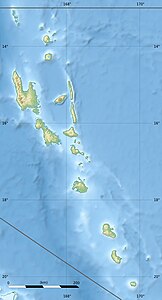Kuwae
| Kuwae | ||
|---|---|---|
| height | 2 m below sea level | |
| location | Vanuatu , Pacific | |
| Coordinates | 16 ° 49 ′ 45 ″ S , 168 ° 32 ′ 10 ″ E | |
|
|
||
| Type | Submarine volcano | |
| Last eruption | 1974 | |
Kuwae is an undersea volcano between Épi and Tongoa , one of the most active volcanoes on Vanuatu . It erupted around 1453 and reached level 6 on the volcanic explosive index .
The eruption
Tongoa and Épi used to be part of a larger island called Kuwae. Local tradition tells of an eruption that destroyed the island and left behind the two current islands and an oval, 12 km × 6 km caldera . The Kuwae eruption was one of the world's largest in the last 10,000 years; between 32 and 39 km 3 of magma were expelled.
In the Antarctic and Greenland , the eruption can be detected using ice cores . The sulphate concentration measured there indicates that the emission of particles was greater than in any eruption since. Ice core analysis allows the event to be dated to 1452 or 1453. The volume of matter emitted was roughly three times that of the Pinatubo eruption in 1991.
Consequences for the climate
The eruption must have led to a cooling of the earth's climate in the following years (see volcanic winter ). An investigation by Kevin Pang of the Jet Propulsion Laboratory found clues in tree rings , ice cores, and historical reports from Europe and China . Oak panels from British portraits indicate extremely narrow rings for the years 1453 to 1455. In Sweden there was no harvest and the grain tithe fell to zero; Western pines show frost damage in 1453. The growth of European and Chinese trees was slowed from 1453 to 1457.
According to the history of the Ming Dynasty in China, incessant snowfall destroyed the wheat in the spring of 1453. In the same year that the dust darkened the sun, “several cubits of snow fell in six provinces; tens of thousands of people froze to death ” . For the year 1454 it is reported: " It snowed for 40 days south of the Yangtze , and countless people died from the cold and hunger ", and the Yellow Sea was frozen up to 20 km off the coast.
The eruption occurred shortly before the conquest of Constantinople , the last bastion of the Byzantine Empire . The Ottoman Turks under Sultan Mehmed II besieged the city from April 5, 1453 and conquered it on May 29. Pang found evidence of the aftermath of the volcanic eruption in chronicles of the city. The gardens of the city produced little this spring. On May 25, a storm raged over the city: " It was not possible to withstand the hail, and the rain poured in such torrents that entire streets were flooded. " On the night of May 22nd, the moon, the symbol of Constantinople, darkened.
Four days later, the entire city was shrouded in a thick fog. As the fog cleared in the evening, " Hagia Sophia appeared immersed in flames, and lights could be seen from the city walls flickering in the distance behind the Turkish camp ". The townspeople said the strange light was a reflection of a fire set by the attackers. It was an optical illusion, however, a reflection of the extremely red twilight of clouds of volcanic ash high up in the atmosphere . Many such 'false fire alarms' were also reported worldwide after the Krakatau eruption in 1883.
The special appearance of Halley's Comet in June 1456 as “ red with a golden tail ”, as reported by contemporary astronomers, was obviously a consequence of the eruption.
Today's activity
Islands have regularly formed in the Kuwae Caldera . The eruption from 1897 to 1901 formed an island that was 1,000 meters long and 15 meters high. She disappeared after six months. The eruption from 1948 to 1949 also formed an island that disappeared again. This disappearance is caused by the waves and the main current of the caldera. The island reappeared briefly in 1959 and 1971.
Current activity in Kuwae is limited to fumaroles , which color the water yellow. Bubbles of hydrogen sulfide reach the surface above the volcanic peak .
See also
swell
- ↑ http://wwwobs.univ-bpclermont.fr/lmv/ird/Van_Kuwae.html ( Memento from March 5, 2005 in the Internet Archive )
- ↑ http://climate.envsci.rutgers.edu/pdf/Kuwae27.pdf
- ↑ http://www.agu.org/pubs/crossref/2006/2005JD006710.shtml
- ↑ http://www.jpl.nasa.gov/releases/93/release_1993_1543.html
- ↑ http://www.mpl.ird.fr/suds-en-ligne/fr/volcan/vanu_eng/karua2.htm#suds
- ↑ http://www.futura-sciences.com/comprendre/d/dossier473-8.php
Web links
- Kuwae in the Global Volcanism Program of the Smithsonian Institution (English)
